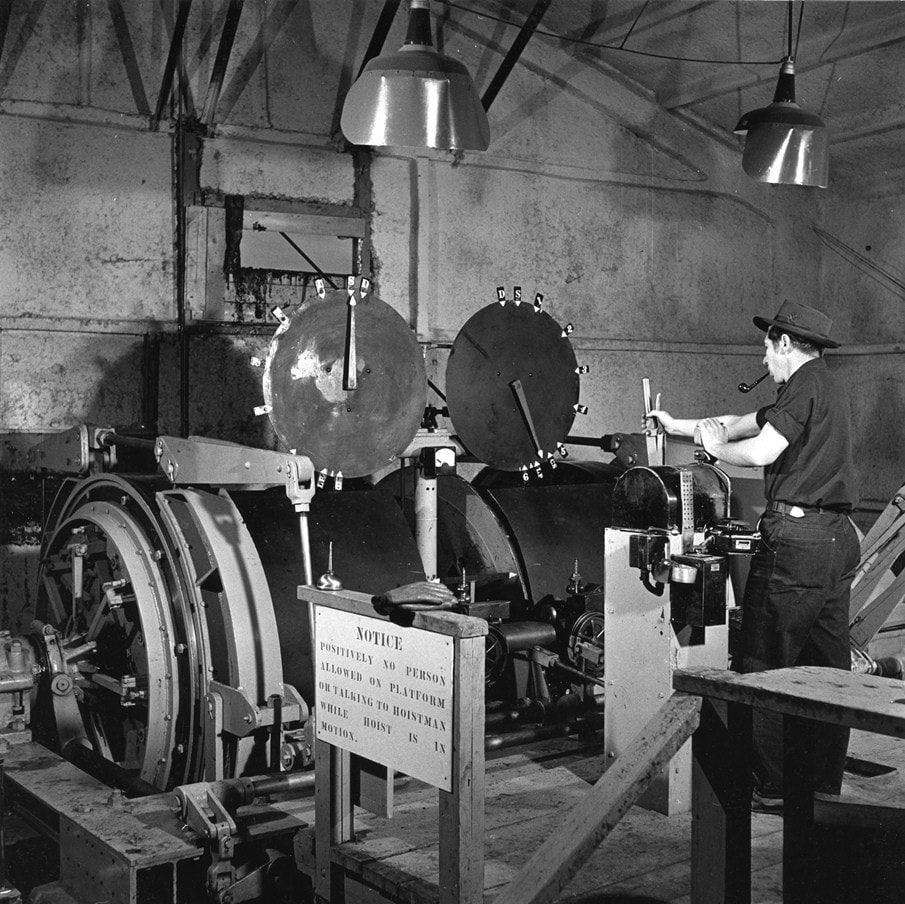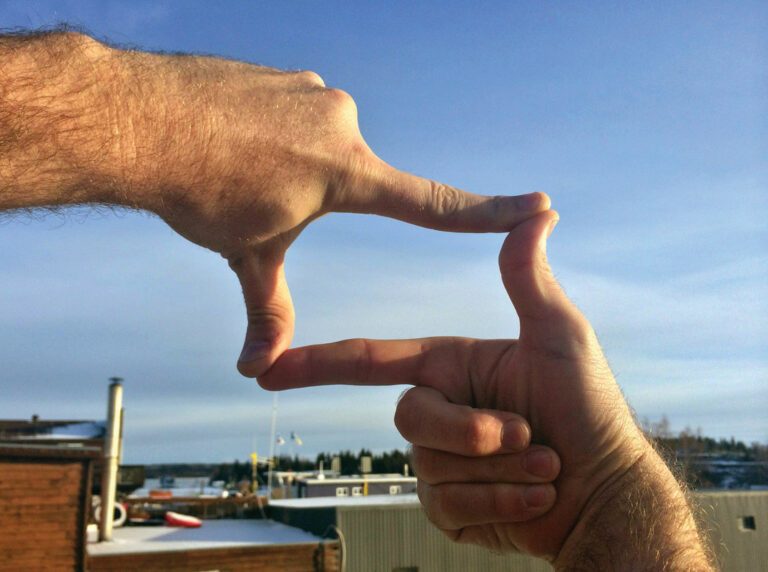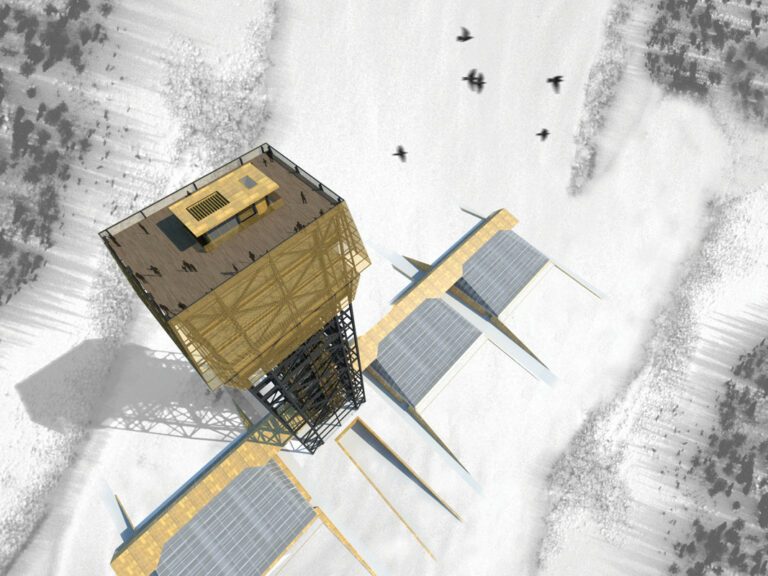For 25 years, Bill Powless began his workday in a steel cage. Below him, a mineshaft, 2000 feet deep. Above him, the C-Shaft headframe – the central point of a huge pulley system that hauled ore to the surface and lowered miners into the depths of the earth. On his daily trips downward, Powless had to keep his elbows tucked inside the cage lest he lose an arm to the beams zipping by. Except for the light from the miners’ headlamps, everything was dark.
Powless, a stope miner, worked a tunnel around 750 feet underground. Arriving at his level, he’d trek along the damp, low-ceilinged passageways branching off C-Shaft at a right angle and out to the newly blasted areas where the geologists had marked the high quality ore in the tunnel’s walls with paint. Drilling holes several feet apart, he’d fill the walls with explosives – dynamite when he started in 1956, and later a sand-like explosive material sprayed through a hose – and detonate the charge. Several hours later, once the noxious fumes had dissipated up the ventilation shafts, he’d return to load the rocks into a chute leading down to the next level, where they’d crash into mine carts headed back to the C-shaft.
There was a whole world underground. Working alongside Powless and his fellow stope miners at the Giant Mine site were engineers, geologists, tradespeople, drift miners and diamond drillers. Each played a well-defined part in the massive operation, which at its peak saw hundreds of workers hauling 1500 to 2000 metric tons of ore to the surface every week. What they all shared was a daily ritual: changing from street clothes into dirty coveralls called “diggers” and stepping into the cage suspended from the C-Shaft headframe.
***
Over the past few months, the iconic headframe has been coming down piece by piece as part of the opening phase of the decades-long (or even centuries-long) Giant Mine remediation project. The wood that formed the original 100-foot-tall structure built in 1949 has been stripped away. Only the steel exoskeleton, added in the 1980s, remains; that too has a short time left to live.
As the name suggests, the C-Shaft headframe wasn’t the first one built on the Giant Mine property. A and B shafts (with their headframes) were sunk at the north and south ends of the property in the mid-1940s for exploration and ventilation purposes, though they were never used for mining proper. C-Shaft came several years later, approximately halfway between the other two shafts and adjacent to the largest deposit on the mine site.
Though some would argue the C-Shaft headframe had a certain architectural beauty to it, like most headframes its design was largely utilitarian. The main function of the structure was to support the weight of the cages and buckets of ore – called “skips” – as they descended or ascended the mineshaft. It was built from sturdy, high-quality fir, and the trellised legs kicked out to one side gave the structure additional support. Thick steel cables ran from the cages and skips up to the top of the headframe, through large wheels and down to a building where the hoistman controlled the lift and communicated with his partner underground using morse code-like bell signals.

Harry Dyck, Giant Mine hoistman, in 1952 | Photo from the George Hunter Collection, courtesy NWT Mining Heritage Society
The hoistman’s job was one of the most important at the mine; they were in charge of getting workers like Powless safely to their working levels. Slacking on the job could cause a lot of damage to property, life and limb – at Con Mine, for example, one person drowned when the cage was lowered into the watery depths of the 6000-foot-deep shaft and another was killed after peering up the shaft into an oncoming cage. In 1957, Rolf Dressler was killed at Giant after being struck by a counter weight in one of the mineshafts.
There were also several hoist-related accidents at the C-Shaft Headframe which didn’t take lives but did do a significant amount of damage. In 1963, a hoistman decided to use a wrench to prop open an emergency brake meant to clamp shut if the cage came too close to the top of the headframe. The cage slammed up into the wheels at the top of the structure and got jammed. That hoistman was promptly replaced.
Every day, skips full of ore were hauled up inside the headframe and dumped into a chute running to the nearby crusher. From there the ore was moved on conveyor belts to the nearby mill and on to the roaster. A weekly load of 1500 to 2000 metric tons of ore would get you between 5000-10,000 ounces of gold, or about 10 gold bars. All told, between 1948 and 2004, 18.1 millions tons of ore was pulled out of the ground and up C-Shaft, yielding 7.1 million ounces of gold.
For some people, like local historian Ryan Silke, the sight of the structure stripped to its bare bones and destined for destruction is somewhat lamentable.
“Across Canada, especially in bush camps, headframes are often referred to as the Cathedrals of the North because they’re so prolific and they are so important to communities,” he says. “That’s a part of our culture that we’re losing, that no one seems to relate to anymore, and that’s tragic, though I guess it’s just the way of the times.
“I don’t see this as unique to Yellowknife though. This is happening across North America, even in the manufacturing centres. Auto plants and whatever else are closing and everything has been exported to other countries. You look at the fishing villages on the East Coast, whole communities have had to change because of industry shutting down, and it is tragic. I really do see industry as part of the landscape and part of our social ties.”
For others like John Carter, who worked in the mine as an electrician in the 1960s and whose father Bert Carter, a foreman at Giant, actually built the structure, the thought of the headframe coming down brings out a more stoic response: “That was then and this is now… I have a picture and for me that’s all I need.”
There are doubtless those who regard the headframe’s destruction in a positive light, a symbolic turn away from the mine’s environmentally destructive legacy and violent history. (Twenty-nine people died on the property over 50 years, including nine in the Sept. 18, 1992 bombing, and a young boy from Ndilo died after drinking arsenic-contaminated water in 1951.) Some might even argue that Con Mine’s towering Lego-cigarette is Yellowknife’s truly iconic headframe. Still, there’s little doubt an important symbol of Yellowknife is on its last legs. Giant’s C-Shaft headframe is, after all, featured on Yellowknife’s coat of arms and flag as well as the 1984 stamp Canada Post issued to commemorate the founding of the city.
***
At this point, the C-Shaft headframe is beyond saving. But Silke and other members of the Mining Heritage Society have been salvaging what they can: signs, equipment and other industrial memorabilia, hopefully to be housed in the mining museum in the old rec hall by the marina once the building is fully renovated in a few years time. They’re also working to save two other headframes on the Giant Mine property. One is the small wooden Brock Shaft, built in 1939, which they hope to relocate to the museum site. The other is the steel Akaitcho Headframe, built in 1950 near the Vee Lake road.
“It’s in good shape, there’s no contamination concerns over there and it could be easily sealed from the shaft to prevent access,” says Silke. “It’s a bit out of the way, not very visible, but it would still be a great monument. We would like to see some interpretive hiking trails heading out that way to celebrate the geology and the human history there, not just the mining but the Aboriginal history.”
As for the C-Shaft headframe, says Silke: “I really hope the City keeps that as a symbol of Yellowknife, because that is where we come from as a modern community: the mining industry. For all the good and the bad that the mining industry has done to the landscape in the Northwest Territories, I still think it’s worth keeping in the public mind. We don’t want to forget where we come from and we don’t want to forget there is that legacy of contamination.”
Powless, now almost 80 and still living in Yellowknife, can’t drive anymore so he hasn’t seen the headframe in years. “I knew it was going to happen sooner or later,” he says, rather dolefully. “I was just wondering how long it was going to take.”







